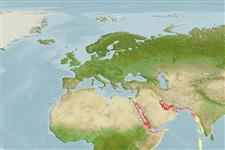Classification / Names
आम नाम | उपशब्द | Catalog of Fishes(वर्ग, प्रजाति) | ITIS | CoL | WoRMS | Cloffa
>
Gobiiformes (Gobies) >
Gobiidae (Gobies) > Gobiinae
Etymology: Gobiodon: Latin, gobius = gudgeon + Greek, odous = teeth (Ref. 45335); bilineatus: Named for its two distinct, bright blue lines through the eye, the remaining distinct colour pattern that remains in the largest adults when alive; from Latin words 'bi' for two and 'linea' for line.
Environment: milieu / climate zone / गहराई सीमा / distribution range
पारिस्थितिकी
समुद्री प्रवाल-भित्ति संयुक्त. Tropical
Indo-West Pacific: most probalby within the whole area; collected from the Gulf of Aqaba, Red Sea.
आकार / वज़न / Age
परिपक्व अवधि: Lm ? range ? - ? cm
Max length : 3.6 cm SL पुल्लिंग / अलिंग; (Ref. 94082)
Short description
पहचान कुंजी | आकृति विज्ञान | मौरफोमैटरिक्स
पृष्ठीय रीढ़ (सम्पूर्ण) : 6; पृष्ठीय सौफट रेज़ (सम्पूर्ण) : 10 - 11; गुदा कांटा: 1; ऐनल सौफट रेज़: 8; जानवरों की रीड़ का जोड़: 26. This species is distinguished by the following characters: D VI+I,10-11; A I,8-9 (usually 9); head and body naked; body slightly compressed and relatively elongate (body depth at pelvic-fin origin 36-40% SL), dorso-ventrally symmetrical; distance between D1 insertion and dorsal insertion of pectoral-fin 53-71% of head length; rounded head with upper lip curved; small mouth, upper jaw extending to anterior margin of the eye; groove between isthmus and interopercle absent; caudal peduncle deep (minimal depth 16.3-17.9% SL); caudal fin relatively short (21.7-23.2% SL). Colour of juveniles and subadults light greenish or reddish with 5 vertical blue lines on head while adults are usually uniformly orange-red or dark red, sometimes with remnants of lines on the head but always with 2 distinct bluish lines through the eyes, sometimes extending ventrally to suborbital area; dorsal and anal fin usually with a narrow light bluish band along bases, fading with growth (Ref. 94082).
Body shape (shape guide): short and / or deep; Cross section: compressed.
Facultative air-breathing in the genus (Ref. 126274); Usually occupies the reef slope and fore reef areas and often in large colonies of Acropora samoensis but also present in Acropora secale and A. gemmifera in northern Red Sea (Ref. 94082).
Life cycle and mating behavior
परिपक्व अवधि | पुनरुत्पत्ति | मछलीऔ का अंडे देना | अंडे | Fecundity | लार्वा
Herler, J., S.V. Bogorodsky and T. Suzuki, 2013. Four new species of coral gobies (Teleostei: Gobiidae: Gobiodon), with comments on their relationships within the genus. Zootaxa 3709(4):301-329. (Ref. 94082)
IUCN Red List Status (Ref. 130435: Version 2025-1)
Threat to humans
Harmless
Human uses
साधन
Special reports
Download XML
इंटरनेट स्रोत
Estimates based on models
Preferred temperature (संदर्भ
123201): 24.8 - 29.3, mean 28 °C (based on 172 cells).
Phylogenetic diversity index (संदर्भ
82804): PD
50 = 0.5000 [Uniqueness, from 0.5 = low to 2.0 = high].
Bayesian length-weight: a=0.01995 (0.00906 - 0.04395), b=3.01 (2.83 - 3.19), in cm total length, based on all LWR estimates for this body shape (Ref.
93245).
Trophic level (संदर्भ
69278): 3.3 ±0.4 se; based on size and trophs of closest relatives
लौटाव (संदर्भ
120179): ऊंचा, न्यूनतम जनसंख्या दुगनी समय अवलागत 15 महीने। (Preliminary K or Fecundity.).
Fishing Vulnerability (Ref.
59153): Low vulnerability (10 of 100).
🛈
